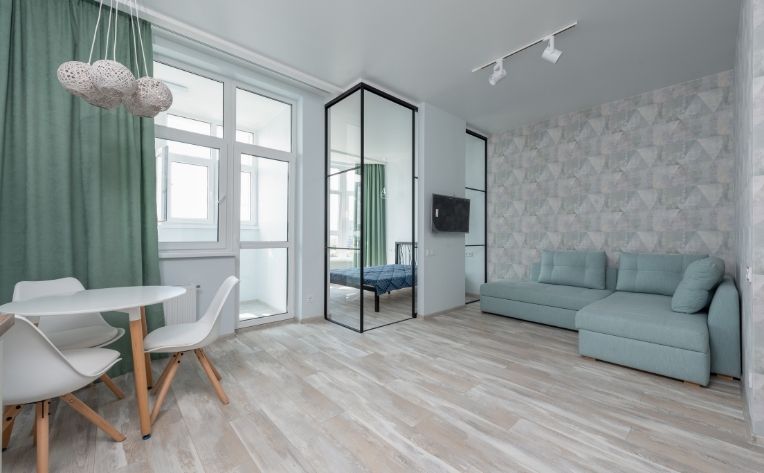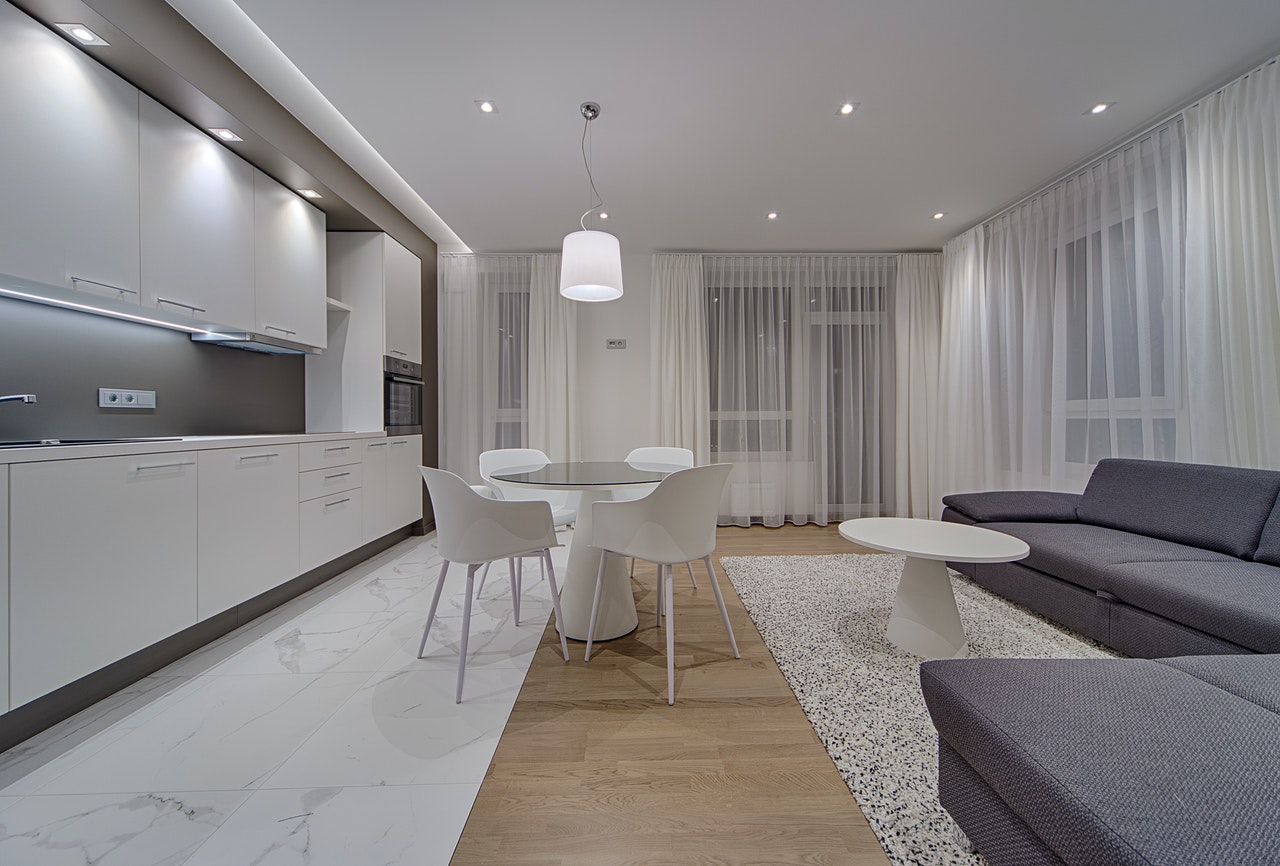Have you ever walked into a small apartment and been surprised by how spacious it felt? Or maybe you’ve struggled to make your own home feel larger, despite its square footage. Often, the answer lies in the colors we choose for our rooms, particularly the flooring. I distinctly remember visiting a friend’s apartment in New York City. It was tiny, but her choice of light-colored wood floors made it feel almost twice the size. Since then, I’ve become fascinated by the ability of flooring color to manipulate our perception of space.

Image: www.flooringamerica.com
The science behind this is surprisingly complex, involving our brains, the way light reflects off surfaces, and even our cultural understanding of space. If you’re looking to make your home feel more expansive, understanding how light color floors play a role is crucial. This article explores the relationship between light-colored floors, room size, and visual perception, helping you unlock the potential for a bigger, brighter home.
The Power of Light and Its Reflection: How Color Affects Perception
Think of a room as a canvas. The way light interacts with the colors on that canvas determines how we perceive its size. Light color floors, like beige, white, or light gray, reflect more light than darker colors. This creates the illusion of depth, making a room feel larger and more open.
Imagine walking into a room with beige floors. The light reflecting off the floor bounces back into the room, increasing brightness and making the walls appear further away. In contrast, dark floors absorb light, creating shadows that make a space feel smaller and more enclosed. So, by choosing lighter floors, you’re effectively maximizing light reflection, tricking your eye into perceiving a more expansive space.
Beyond Reflection: The Role of Color Psychology
While light reflection is a significant factor, color psychology also plays a role in how we perceive color and space. Light colors, particularly whites and pale browns, often symbolize expansiveness, cleanliness, and airiness. This association reinforces the visual cue of increased space created by light reflection.
Additionally, light colors have a tendency to draw the eye upward, expanding the visual perception of a room’s height. This effect is further enhanced when paired with lighter wall colors, creating a seamless flow of light and space.
The Importance of Contrast: Balancing Light and Dark
It’s important to note that using exclusively light colors can sometimes make a space feel sterile or lackluster. Achieving a sense of balance is crucial. Introducing darker elements through furniture, rugs, or accents helps break up the lightness and adds depth and visual interest. A light colored floor acts like a blank canvas, allowing for the accent pieces to “pop” and create visual focal points.
Ultimately, the key is to find a balance between light and dark, leveraging the reflective qualities of light colors while embracing the grounding effect of darker elements. This balanced approach ensures the room feels spacious and welcoming, rather than sterile and overwhelming.

Image: www.posteakfurniture.com
Tips from Experts: Making the Most of Light Flooring
While light color floors offer a multitude of visual benefits, achieving the desired effect requires careful consideration. Here are tips from design professionals on how to maximize the impact of your light-colored floors:
Prioritize Natural Light:
One of the most significant factors in amplifying the effect of light-colored floors is to maximize natural light. This means strategically placing your furniture to avoid blocking windows, adding light-reflecting mirrors, and keeping windows clean and unobstructed. The more natural light you can bring in, the better your light floors will reflect and amplify the overall brightness of the room.
Choose the Right Undertones:
Not all light colors are created equal. Warm undertones, like those found in beige and cream, can create a cozy, inviting atmosphere. Cool undertones, such as those in gray and white, can make a space feel crisp and modern. Consider the overall feel you want to achieve for your space when choosing your specific shade of light color flooring.
Embrace Natural Materials:
Pairing light-colored floors with natural materials, such as wood, stone, or linen, can create a sense of warmth and sophistication. These materials offer a sense of grounding and texture that contrasts beautifully with the lightness of the floor, adding visual interest and depth to the space.
Play with Patterns:
Don’t be afraid to use patterns, especially on carpets or rugs placed on light-colored floors. Geometric patterns can add visual interest and break up the monotony of large areas of light color. This helps create a sense of visual depth and keeps the space from feeling too sterile.
FAQ: Common Questions about Light Color Floors
Q: Can light-colored floors make a room feel too cold or sterile?
A: This is a valid concern. While light colors can create a sense of expansiveness, they can also feel cold if not carefully balanced with other elements. Consider using warm undertones in your flooring, choosing furniture with warm, inviting colors, and adding touches of natural materials to create a cozy atmosphere.
Q: Does it matter what type of flooring I choose—wood, tile, laminate?
A: While the color is the primary factor in creating the illusion of space, the type of flooring you choose also plays a role. Wood flooring tends to be more forgiving of imperfections, while tiles can create sharper lines that may accentuate the size of a room. Ultimately, the best flooring choice will depend on your personal preference, budget, and the style of your home.
Q: What if my house has older, darker wood floors? Can I still make the space feel bigger?
A: Absolutely! While you may not want to completely replace your existing floors, there are still ways to brighten the space. Consider painting the walls a lighter color, adding light-colored rugs to cover areas of your darker flooring, and using furniture and accessories to bring in more light and create a sense of spaciousness.
Do Light Color Floors Make A Room Look Bigger
Conclusion
In conclusion, light color floors can be a powerful tool for creating the illusion of a larger, brighter space. By understanding the principles of light reflection, color psychology, and the importance of contrast, you can make the most of this design trick to transform your home. It’s important to remember that while light floors can create a sense of spaciousness, they should be balanced with other elements to create a cohesive and inviting environment. So, whether you’re embarking on a complete renovation or simply looking for a quick fix to enhance the feeling of space in your home, remember the power of light-colored floors!
Are you interested in learning more about how to incorporate light color floors into your home, or do you have any further questions about the topic? Share your thoughts and experiences in the comments below!






